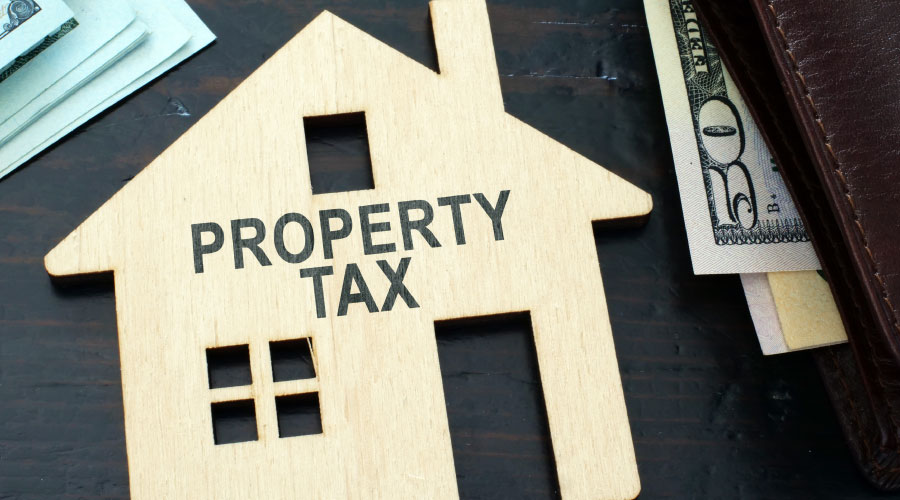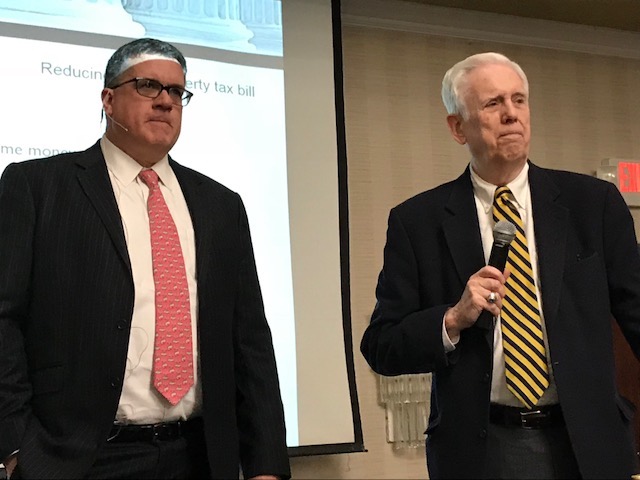Make no bones about it: Ohio property taxes are complicated.
And with today’s dramatic upwardly dynamic real estate market, it is more important than ever that buyers and sellers carefully consider the impact of a sales price that exceeds the Auditor’s valuation when writing a purchase contract’s tax proration provision.
Ohio’s complicated property taxation structure
First, taxes in Ohio are billed semi-annually, in roughly January and July of each year. Those two bills are, respectively, for the first half and second half of the prior calendar year. So, the January 2022 bill will be for the first half of 2021, and the July bill will be for the second half of 2021. Thus, when a buyer buys property, the seller owes between seven and thirteen months of taxes in arrears.
How tax prorations are typically addressed in “form” contracts
Typically, the purchase contract will provide for several things so that the seller credits these accrued but not-yet-due taxes to the buyer:
- First, there will be a proration of taxes from the seller to the buyer from January 1 of the year of the closing, or July 1 of the year prior to the closing, through the date of closing.
- (In what I consider to be a weird local custom, in the Dayton marketplace only, a “short proration” is many times utilized for residential and commercial transactions. The “short proration” ignores the first six months of arrearage, and prorates only on the part-half-year immediately prior to the closing. I do not know the logic behind this.)
- Second, the amount of that proration in a form residential and commercial purchase contact is typically to be “based upon the most recent available tax duplicate.” Many times the contract (and/or documents signed at the closing) specifies that the tax proration is to be considered “final.”
- [NOTE: The new Cincinnati Area/Dayton Area Board of Realtors standard form of residential real estate contract issued in the fall of 2021 is emphatic on this topic: Tax prorations are based upon “the most recent available tax rates, assessments and valuations” and “all tax prorations shall be final at Closing.”]
What does “based upon most recent available tax duplicate” mean?
On this, issue of prorating taxes “based upon the most recent available tax duplicate,” consider a few things:
- In Ohio, the starting point for the Auditor’s value is the actual value, i.e., what a willing buyer would pay a willing seller for the property. It’s the same number used by buyers, sellers, appraisers and lenders for the property value, i.e., the actual sales price. There is no other magical number. (Then, we speak in terms of 35% of that value as that is translated in the tax bill, but that number has no practical impact except to confuse people and does not change the analysis set forth in this blog entry.)
- Secondly, the “most recent available tax duplicate” means the taxes to-be-paid, which is valuation times tax rate on the Auditor’s records as of the date of closing.
- But both the tax valuation and the tax rate can change — with retroactive effect — all the way through the date the tax bill is issued in January of the following year, meaning well after the closing, or even by August or September of that following year when a tax valuation complaint before the Board of Revision is decided. Indeed, if a valuation complaint is appealed all the way to the Ohio Supreme Court, taxes could be assessed with retroactive effect two, three or more years after a closing date.
- (We primarily address valuation issues in this blog entry, but if a levy is on the ballot in May or November of any year, that rate increase also dates back to January 1 of that year, so a large tax levy can result in an inequitable tax proration as well.)
A sale price above Auditor’s value may result in a retroactive tax increase
In today’s dynamic real estate market in which sales prices of certain properties are galloping upward at an astonishing pace, especially for apartment buildings, single family residences, and industrial and warehouse properties, that standard form language could leave an unsuspecting buyer holding the bag. Here’s why:
- First, County Auditors update their valuations once every three years, and the cutoff for those updates is around September 30 of that year. So, for a sale in a “triennial year” (six different triennial cycles for Ohio’s 88 counties) prior to September 30 of that year, the Auditor should, on his own, increase the valuation to the sales price retroactive to January 1 of that first year of the triennial (even if the sale is late in that year), but that increase only becomes reflected on the tax records when the valuation comes out with the January bill of the year subsequent to the applicable tax year.
- But Auditors typically do not adjust values on their own after that date and in the “off” two years between the triennial valuation cycles. So, Hamilton, Montgomery, Butler and Clermont Counties most recently updated valuations effective January 1, 2020, and those values came out with the January 2021 tax bills. The Auditor’s of each of those Counties won’t “catch” a sale made after September 30, 2020 until the 2024 tax bills (values effective January 1, 2023).
- Ohio law says that — with narrow and rare exceptions — the sale price is the correct property valuation. Thus, property owners have a difficult time arguing that the contract sale price is not the actual value of the property.
- The contract sale price is reported to the Auditor with an “Real Property Conveyance Fee Statement of Value and Receipt” (“Conveyance Fee Statement”) signed by the purchaser at each closing. It is a felony to falsify one of these forms.
It’s easy to ascertain if the sale price is above the Auditor’s valuation. Each County publishes their valuations — current as of the date of contract signing — on its web site.
School districts can and do seek retroactive valuation increases
The biggest beneficiary of property taxes in Ohio is the local school board, which typically receives about two-thirds of the total tax bills into their coffers.
As a result, school districts hire attorneys skilled in property valuation matters to scour the Auditor’s records to find recent sales in their district that exceed Auditor’s valuation. Then, they file Board of Revision complaints to seek an increase in valuation. Some points on those complaints:
- Those complaints are filed, as with property owner complaints seeking a reduction, between January 1 and March 31 of each year.
- Those complaints by law seek a retroactive increase in taxes to January 1 of the prior year. So, for example, complaints filed in the first quarter of 2022 will apply retroactively to January 1 of 2021, and the increased taxes are a lien on the property as of that prior year (e.g., January 1, 2021).
- Almost universally, school districts limit their complaints to sales of a certain minimum variance from Auditor’s valuation (say, $50,000 or $100,000) and usually they ignore single family residential properties.
- The buyer — the new property owner — should receive notice of the complaint, and could appear to oppose the increase. But the an arm’s length sales price is, by law, the correct valuation and the Conveyance Fee Statement is usually prima facie evidence of both that contract price and the arm’s length nature of the transaction.
These school board complaints, if successful, have two effects: (i) in the tax year of the Complaint, it puts real cash in the pocket of the school district (the tax hike is very roughly about 3.0% of the valuation increase and the school district gets about two thirds of that one-time cash amount), and (ii) thereafter it ever-so-slightly reduces the burden on other property owners to have each property valued at its correct rate.
A post-closing surprise!
This means that buyers can get a surprise of a tax bill far in excess of the prorated taxes (otherwise by law owed by the seller) well after the closing date. And typically contract language and perhaps papers signed at the closing make this difference unrecoverable by the buyer as against the seller.
How to address this issue in the contract
From a buyer’s perspective, if he wants to recover a proration that will fully compensate him for taxes due (by seller) accruing prior to closing, he must deviate from the typical contract language that a tax proration is to be “based upon the most recent available tax duplicate” to add “but updated to reflect the sale price in this contract” or something to that effect. A further possibility with an entirely solvent seller whose operation would continue well after the closing would be to call for a re-proration after the actual taxes are known. But it’s far better to adjust at closing so a post-closing claim (or law suit) is not necessary.
If the issue is not addressed in the contract but brought up before or after closing, it may be difficult to argue to the seller that the contract does not reflect the seller’s actual tax liability as of the closing date.
From a seller’s perspective, it is better use the typical default language of “based upon the most recent available tax duplicate.”
Obviously, if the contract price is lower than the Auditor’s valuation, the default language” of “based upon the most recent available tax duplicate” would disadvantage the seller and benefit the buyer. This frequently was so in the last (and every) real estate recession, and may be true with isolated sales occurring today, or for certain categories of real estate such as restaurants and hospitality, parking garages, and retail. When this happens, a seller may want to ask to prorate based on the actual sale price rather than the “most recent available tax duplicate” information. In the alternative, the seller could preserve the right to pursue a reduction in valuation post-closing and receive any refund arising from an over-payment or excess proration.
Ohio courts have addressed this precise question: What happens when, after closing, additional taxes are retroactively assessed for periods prior to closing due to an increase in value? Under the default “based upon the most recent available tax duplicate” language, the answer is that typically these additional taxes become the buyer’s responsibility.
In Lone Star Equities, Inc. v. Dimitrouleas, 2d Dist. Montgomery No. 26321, 2015-Ohio-2294, the seller filed a Board of Revision (“BOR”) complaint seeking a reduction in the value of his property and received such reduction. The local school board then appealed that reduction to the Board of Tax Appeals (“BTA”). While the BTA appeal was pending, the seller sold the property to the buyer for significantly more than the value to which the property was reduced at the BOR level and gave the buyer a general warranty deed disclaiming all encumbrances. The BTA hearing was held approximately one year after the closing, and (because he no longer owned the property) the seller did not attend. The buyer was seemingly unaware of the proceeding and, thus, did not attend the BTA hearing either. The BTA ended up increasing the value to what it was before the BOR reduction (i.e., the value sought by the school board). This created a retroactive tax assessment of nearly $34,000 relative to periods prior to the closing. The buyer paid those taxes and then sued the seller for breach of contract, breach of warranty, and fraud to recoup the same.
The applicable tax provision in the Lone Star case read as follows:
- Taxes: All installments of real estate taxes, and any other assessments against the Property, that are due and owing prior to Closing shall be paid by Seller regardless if the tenant reimburses Seller for same. The taxes and any other assessments assessed for the current year shall be prorated between Seller and Purchaser on a calendar year basis as of the closing date.”
(Emphasis added). There was no language to indicate what would happen should a tax be retroactively assessed for periods prior to closing, but the buyer argued that the seller should be responsible for the taxes under the above contract language, and that he knew of the pending BTA matter and knew that the tax proration on the HUD-1 settlement statement wasn’t final and fraudulently misrepresented the same.
As to the breach of contract claim, courts have long held that any contract claims will “merge” with the deed upon closing. “The doctrine of ‘merger by deed’ holds that whenever a deed is delivered and accepted ‘without qualification’ pursuant to a sales contract for real property, the contract becomes merged into the deed and no cause of action upon said prior agreement exists. The purchaser is limited to the express covenants of the deed only.” Id., at ¶ 29, citing 80 Ohio Jurisprudence 3d (1988) 91, 93, Real Property Sales and Exchanges, Sections 58-59; Brumbaugh v. Chapman (1887), 45 Ohio St. 368, 13 N.E. 584; Fuller v. Drenberg (1965), 3 Ohio St.2d 109, 32 O.O.2d 91, 209 N.E.2d 417, paragraph one of the syllabus. Cf. Dillahunty v. Keystone Sav. Ass’n. (1973), 36 Ohio App. 2d 135, 65 O.O.2d 157, 303 N.E.2d 750.
In other words, after closing occurs, the parties no longer have viable claims arising out of the contract – they only have claims arising out of the deed. This largely shifts the burden to the parties, making it incumbent upon them to do their due diligence in making sure all of the respective contractual obligations have been met prior to closing. For example, if a contract addendum calls for the seller to make certain repairs prior to closing, but the seller fails to fulfill this obligation and the closing occurs anyway, the buyer cannot later sue the seller for breach of contract in failing to make the repairs. This is because the contract “merged” with the deed, and the deed did not call for any repairs. The court in Lone Star applied this doctrine of merger by deed to rule in favor of the seller as to the buyer’s breach of contract claim.
Perhaps two of the most common exceptions to the doctrine of merger by deed are (a) explicit contractual language dictating a specific contractual term shall “survive the closing” and/or “survive delivery of the deed” (this defies the doctrine’s “acceptance, without qualification, of the deed” requirement), and (b) fraud. In the Lone Star case, there was no contractual language indicating that the tax provision would survive closing and/or delivery of the deed. Likewise, the court found no fraud on the part of the seller.
One of the required elements to prove a fraud claim is “justifiable reliance.” See Lone Star, at ¶ 59, citing Volbers-Klarich v. Middletown Mgmt., 125 Ohio St.3d 494, 2010-Ohio-2057, 929 N.E.2d 434, ¶ 27; Burr v. Board of County Comm’rs, 23 Ohio St. 3d 69, 73, 23 Ohio B. 200, 491 N.E.2d 1101 (1986). A party cannot justifiably rely on any representation when he or she is on notice to the contrary. Because BOR and BTA proceedings are matters of public record, the buyer was put on constructive notice of the school district’s efforts to have the property’s taxable value increased, even if the seller had a duty to and failed to disclose these proceedings (which was not specifically addressed). Lone Star, at ¶ 65. Because neither of these exceptions applied, the contract merged with the deed at closing, and the buyer could not prevail on its breach of contract claim or its fraud claim.
Finally, the court addressed whether the retroactive tax assessment constituted an encumbrance insofar as it applied relative to periods prior to closing. Answering that question in the negative, the court found that “the tax lien does not attach and become an encumbrance on property until the time that a final determination of valuation is made, and the current property owner, not the former owner, will be responsible for the taxes that have attached.” (i.e., the “‘relation back’ concept in R.C. 5715.19(D) does not mean that the taxes would have attached as a lien prior to the closing.”). Id., at ¶ 53-55. Because the tax assessment did not constitute an encumbrance until after the closing when the BTA made its final determination as to the value of the property, it was not an encumbrance as of the date of closing and, thus, there was no breach of the general warranty deed covenants.
The Lone Star case is a cautionary example of what can happen should the buyer fail to do its diligence in checking for tax appeals and/or insist upon the language discussed in this entry to protect him or her in the event of a post-closing tax assessment. As a firm, we regularly represent both property owners and school districts in BOR and BTA proceedings, and we also have several seasoned real estate attorneys who can help you explore the tax implications of a transaction or post-closing tax assessment.
Conclusion
For help with your commercial or residential real estate contracting matter, including the intricacies of Ohio and Kentucky tax prorations, contact Isaac T. Heintz (513.943.6654), Eli N. Krafte-Jacobs (513.797.2853), or Casey Jones (513.943.5673) of our real estate group.









